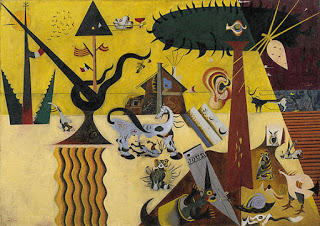Walking this morning in brilliant sunshine in a Mediterranean pine forest was an exercise in delight. The amazingly intense blue sky above was the perfect foil for a myriad dancing greys of tree trunks that twisted and swayed in graceful coexistence. Beneath, the grey-green sheen of resinous shrubs seemed to reflect the light back upwards to the pines and complete the harmony with the bright green crowns of pine needles. Beneath, luminous pink and white touches of rock roses (cistus) were punctuated by the magenta spears of tiny wild gladioli.
Read MoreMiro Foundation
Same Exhibit, Different Venues - how to see Miro /
Sometimes one is lucky enough to catch the same exhibition at different venues, and it is then extremely interesting to see how the different presentation affects the exhibits feel.
This happened to me when I had first see Joan Miro. The Ladder of Escape at the Tate Modern in London last year, and found that the same exhibition is now showing at the Joan Miro Foundation in Barcelona until 18th March.
Of course, in my personal opinion, the actual buildings cannot be compared, with the Joan Miró Foundation, white, elegant and sprawling along the hill crest over down town Barcelona as an eloquent evocation of the Mediterranean world, being the far more compatible venue. Nonetheless, it is when you enter the exhibition that its presentation becomes interesting to observe.
The Tilled Field, Joan Miró, 1923-24, Image courtesy of the Solomon R.Guggenheim Museum
In the Tate version, the early Miró paintings of the Mont-roig world, near Barcelona, in which he grew up and which marked him so deeply, were spread out far apart, even in different rooms. In Barcelona, the Mont-roig world was powerfully evoked by grouping all these wonderful early, seminal paintings together in the same, rather intimate area. One of the most evocative, and important as the first of Miró's Surrealistic paintings, is The Tilled Field, painted in 1923-24.
Santiago Calatrava's Communications Tower, Barcelona
As an aside, this painting also fascinated me because it contains a wonderful herald to Santiago Calatrava's sculpture-communications tower that takes flight into the air nearby in the Montjuic heights of Barcelona, near the 1992 Olympic stadium. Depending on the angle at which you view the Communications Tower, it has very much the same feel as the left-hand symbol in Miró's painting above.
The Miró Foundation grouped together all the Catalan Peasants paintings, with their wonderful shorthand that Miró used to express his feelings about Catalonia, the peasants with guitars, his tussle between voids in the painting and the need to fill these voids or leave them free. The effect was far more powerful and interesting to see these works together, with their progressions and differences, as compared to their spacious presentation by the Tate Modern.
The same intimate, interesting effect was achieved in Barcelona by a much closer juxtaposition of the wonderful Constellations series. Beyond, the presentation was more reminiscent of that done by the Tate, mainly because the later Miró canvases became much bigger, bolder and fewer in series - that meant that they could be hung in rooms, series by series. Nonetheless, there were interesting pauses and changes in pace as at the Miró Foundation, there are Miró sculptures, many small and whimsical, in addition to his single marble sculpture, the Solar Bird and some of the wonderful ceramic ones out on the wide terrace with the Barcelona cityscape as the sunlit backdrop.
This fascinating exhibition travels next to the National Gallery of Art in Washington, DC. It would be so interesting to catch it there too and see what differences can be achieved and nuances explored at yet another, different venue.

